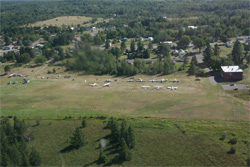 Brad Frederick has a motto for the airport he transformed from an abandoned, overgrown field to a pillar of the local community: “If you mow it, they will come.”
Brad Frederick has a motto for the airport he transformed from an abandoned, overgrown field to a pillar of the local community: “If you mow it, they will come.”
Prickett-Grooms Airfield (6Y9), a grass strip in a remote area of Michigan’s Upper Peninsula, was closed by the state in 2004 and had fallen into disrepair when the local township supervisor approached Frederick about trying to reopen the airport. Frederick donated the money to buy the airport and reopened it in 2006. He has improved the airfield and uses it to promote the history and culture of the area.
Frederick maintains the airfield as director of the Southern Houghton County Airport and Heritage Association, a nonprofit organization dedicated to preserving Prickett-Grooms and the history of the community. The association operates a small museum in a converted church nearby and is recreating a piece of the airfield’s history as a training base for L-4 Grasshoppers during World War II. But Frederick is not just looking to the past; he is planning a future that brings economic and cultural benefits to the community. “We’re trying to get this airfield going, get more interest going in it, and potentially get some industry,” he said.
Located in the small town of Sidnaw, Mich., Prickett-Grooms Airfield was used for commerce, airmail, and military training in the first half of the twentieth century. By century’s close, however, it saw little traffic. A fatal accident in 2003 led to the airport’s closure, and it was put up for sale in 2004. Frederick and the township supervisor approached the township with an offer to keep Prickett-Grooms operating as an airport: Frederick would donate the money for the township to buy the field. The township turned down the offer. The men extended the same offer to the county, with the same result. Neither government wanted to take on the cost of operating the airport.
Undeterred, Frederick found another way to reopen Prickett-Grooms. The neighboring township helped him procure the airfield to run it himself through a nonprofit organization. The field now operates through volunteer efforts and donations. Frederick’s son Ed is the airport manager, and local volunteers run a museum in coordination with the airport.
The field celebrated its reopening in 2006 with a Labor Day fly-in that now is an annual event. Inspired by attendance at the first year’s fly-in, members of the community started a street fair to coincide with the event. The first year drew 11 aircraft, the next year 19, and last year 21. This year, Frederick said, “The sky’s the limit.”
In reopening the airfield, Frederick made safety the top priority. Volunteers cut trees on both approach ends, created better drainage, relocated the windsock to a more visible location, put out a segmented circle, and built a pilots’ shelter. A key improvement has been the lengthening of the runway from 2,000 feet to 2,600 feet. Frederick said that the Michigan Department of Transportation’s airport inspections manager, Randy Coller, helped to reopen the field so that the area would have an airport.
In keeping with the airport’s mission to preserve local history, a guard tower from a nearby World War II camp for German prisoners of war is being relocated to the field. Frederick hopes to build a World-War-II-style hangar and acquire an L-4 Grasshopper for the field with future donations. In the winter, when the grass field cannot operate as an airport, it is used for community fundraisers, including a Habitat for Humanity event. Frederick said that such events build community support.
Revitalizing the airport has helped make the area more accessible, provided a temporary base for rescue operations, and drawn in members of the community —as well as supplied a motivation for Frederick to realize his lifelong dream of becoming a pilot.
Frederick had wanted to fly since he was six years old. But growing up on a farm, he could never afford to learn. Later, the responsibilities of raising a family and running a business kept him from getting a pilot certificate.
The opportunity came after his oldest son became a pilot. Frederick’s son had looked forward to using the field to reach the family’s cabin near Prickett-Grooms Airfield; flying would have turned the eight-hour drive into a two-and-a-half hour flight. But the closure of the field in 2004 kept him from using it. After Frederick began operating the airfield, his son offered to teach him to fly if he paid for his CFI training. Frederick’s son became a CFI, Frederick became a private pilot, and now Frederick flies up to the field regularly to maintain it. “I spend a lot of time cutting grass,” he said.
As the airport association continues to plan improvements, Frederick said that he hopes that his efforts encourage others who are trying to save airports. Recalling his own experiences as a child watching aircraft overhead, Frederick said that he makes a special effort to get children involved in the annual fly-in.
If the airfield inspires another young child to take up flying, he said, he has done his job.

